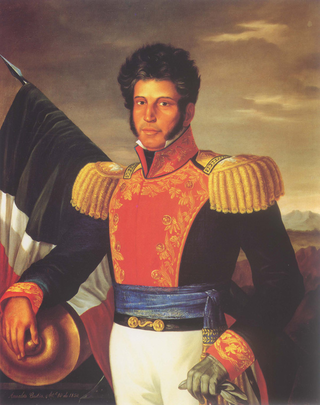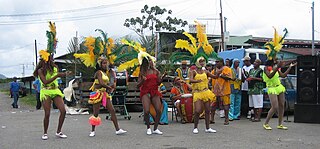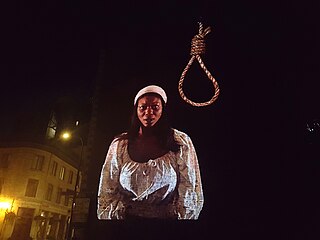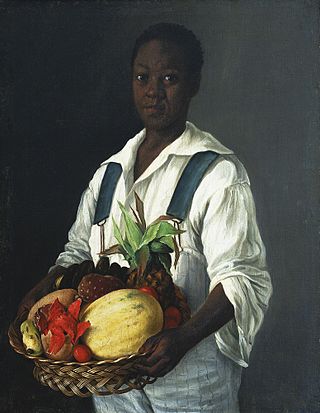
The Atlantic slave trade or transatlantic slave trade involved the transportation by slave traders of enslaved African people, mainly to the Americas. The outfitted European slave ships of the slave trade regularly used the triangular trade route and its Middle Passage, and existed from the 16th to the 19th centuries. The vast majority of those who were transported in the transatlantic slave trade were from Central and West Africa who had been sold by West African slave traders mainly to Portuguese, British, Spanish, Dutch, and French slave traders, while others had been captured directly by the slave traders in coastal raids; European slave traders gathered and imprisoned the enslaved at forts on the African coast and then brought them to the Americas. Except for the Portuguese, European slave traders generally did not participate in the raids because life expectancy for Europeans in sub-Saharan Africa was less than one year during the period of the slave trade.

Slavery in the colonial history of the United States refers to the institution of slavery as it existed in the European colonies which eventually became part of the United States. In these colonies, slavery developed due to a combination of factors, primarily the labour demands for establishing and maintaining European colonies, which had resulted in the Atlantic slave trade. Slavery existed in every European colony in the Americas during the early modern period, and both Africans and indigenous peoples were victims of enslavement by European colonizers during the era.

Slavery in the Spanish American colonies was an economic and social institution which existed throughout the Spanish Empire including Spain itself. Indigenous peoples were enslaved and their populations decimated. Subsequently enslaved Africans were brought over. Native people were also subjected to forced conversions and conscription.
Genízaros was the name for detribalized Native Americans (Indians) from the 17th to 19th century in the Spanish colony of New Mexico and neighboring regions of the American southwest. Genízaros were usually women and children who had been captured in war by the Spanish or purchased from Indian tribes who had held them captive as slaves. To circumvent Spanish laws forbidding slavery, the purchaser of a genízaro had the obligation to introduce them to Christianity and Spanish customs. Genízaros worked as indentured servants, shepherds, and laborers. They occupied the lowest rung of status-conscious Spanish society in New Mexico but slowly assimilated and intermarried into Spanish and later Mexican (1821-1846) and American society. The descendants of genízaros are also called genízaros and the word has become a term of pride for the descendants of the original Indian captives and slaves. In 1793, genízaros are estimated to have comprised up to one third of the 29,041 people living under Spanish rule in New Mexico.

Afro-Mexicans played an important role in the Mexican War of Independence, most prominently with insurgent leader Vicente Guerrero, who became commander in chief of the insurgency. The initial movement for independence was led by the American-born Spaniard priest Miguel Hidalgo y Costilla in central Mexico. White Mexicans quickly abandoned the movement for independence which had become more of a social revolution, with Indians, Blacks, mixed-race castas, and other plebeians seeking social equality. The movement for independence remained active on the Gulf Coast and the Pacific Coast, where there were large concentrations of Afro-Mexicans. The royal army and the insurgent forces had reached a stalemate militarily, but the equation changed in 1820. American-born Spaniard and royalist officer Agustin de Iturbide sought an alliance with the insurgents led by Guerrero. Iturbide and the white creoles sought independence, but expected that racial hierarchies would continue in the post-independence period. Guerrero and other Afro-Mexicans demanded that they would be equal citizens and not until Iturbide acceded to that demand did the Afro-Mexican forces sign on to the Plan of Iguala which laid out the terms for the insurgency movement.

Slavery was practiced in Massachusetts bay by Native Americans before European settlement, and continued until its abolition in the 1700s. Although slavery in the United States is typically associated with the Caribbean and the Antebellum American South, enslaved people existed to a lesser extent in New England: historians estimate that between 1755 and 1764, the Massachusetts enslaved population was approximately 2.2 percent of the total population; the slave population was generally concentrated in the industrial and coastal towns. Unlike in the American South, enslaved people in Massachusetts had legal rights, including the ability to file legal suits in court.

Afro-Costa Ricans are Costa Ricans of African ancestry.

Slavery among Native Americans in the United States includes slavery by and enslavement of Native Americans roughly within what is currently the United States of America.

The Catholic Church and slavery have a long and complicated history. Slavery was practiced and accepted by many cultures and religions around the world throughout history, including in ancient Rome. Passages in the Old Testament sanctioned forms of temporal slavery for Israelites as a means to repay a debt. Slaves, captured in war or purchased, and their children were enslaved for life. After Christianity was legalized under the Roman empire, sentiment grew that many kinds of slavery were incompatible with Christian justice. Views ranged from rejecting all forms of slavery to accepting slavery subject to certain restrictions. The Christian West almost entirely enforced that a free Christian could not be enslaved, for example as a captive in war. However, this was not consistently applied throughout history. The Middle Ages witnessed the emergence of orders of monks such as the Mercedarians who focused on ransoming Christian slaves. By the end of the Medieval period, enslavement of Christians had been largely abolished throughout Europe, although enslavement of non-Christians remained permissible and was revived in Spain and Portugal. Slavery remained a subject of debate within the Church for centuries, with several Popes issuing bulls on the issue, such as Sublimis Deus.

Slavery in New France was practiced by some of the indigenous populations, which enslaved outsiders as captives in warfare, until European colonization that made commercial chattel slavery become common in New France. By 1750, two-thirds of the enslaved peoples in New France were indigenous, and by 1834, most enslaved people were black.

During and after the European colonization of the Americas, European settlers practiced widespread enslavement of Indigenous peoples. In the 15th Century, the Spanish introduced chattel slavery through warfare and the cooption of existing systems. A number of other European powers followed suit, and from the 15th through the 19th centuries, between two and five million Indigenous people were enslaved, which had a devastating impact on many Indigenous societies, contributing to the overwhelming population decline of Indigenous peoples in the Americas.

Afro-Mexicans, also known as Black Mexicans, are Mexicans who have heritage from sub-Saharan Africa and identify as such. As a single population, Afro-Mexicans include individuals descended from both free and enslaved Africans who arrived to Mexico during the colonial era, as well as post-independence migrants. This population includes Afro-descended people from neighboring English, French, and Spanish-speaking countries of the Caribbean and Central America, descendants of enslaved Africans in Mexico and those from the Deep South during Slavery in the United States, and to a lesser extent recent migrants directly from Africa. Today, there are localized communities in Mexico with significant although not predominant African ancestry. These are mostly concentrated in specific communities, including the populations of the Oaxaca, Huetamo, Lázaro Cárdenas, Guerrero, and Veracruz states.

Afro-Nicaraguans are Nicaraguans of Sub-Saharan African descent. Five main distinct ethnic groups exist: The Creoles who descend from Anglo-Caribbean countries and many of whom still speak Nicaragua English Creole, the Miskito Sambus descendants of Spanish slaves and indigenous Central Americans who still speak Miskito and/or Miskito Coast Creole, the Garifunas descendants of Zambos expelled from St. Vincent who speak Garifuna, the Rama Cay zambos a subset of the Miskito who speak Rama Cay Creole, and the descendants of those enslaved by the Spanish.

Slavery in Spain can be traced to the Phoenician and Roman eras. In the 9th century the Muslim Moorish rulers and local Jewish merchants traded in Spanish and Eastern European Christian slaves. Spain began to trade slaves in the 15th century and this trade reached its peak in the 16th century. The history of Spanish enslavement of Africans began with Portuguese captains Antão Gonçalves and Nuno Tristão in 1441. The first large group of African slaves, made up of 235 slaves, came with Lançarote de Freitas three years later. In 1462, Portuguese slave traders began to operate in Seville, Spain. During the 1470s, Spanish merchants began to trade large numbers of slaves. Slaves were auctioned at market at a cathedral, and subsequently were transported to cities all over Imperial Spain. This led to the spread of Moorish, African, and Christian slavery in Spain. By the 16th century, 7.4 percent of the population in Seville, Spain were slaves. Many historians have concluded that Renaissance and early-modern Spain had the highest amount of African slaves in Europe.

Slavery in Latin America was an economic and social institution that existed in Latin America before the colonial era until its legal abolition in the newly independent states during the 19th century. However, it continued illegally in some regions into the 20th century. Slavery in Latin America began in the pre-colonial period when indigenous civilizations, including the Maya and Aztec, enslaved captives taken in war. After the conquest of Latin America by the Spanish and Portuguese, of the nearly 12 million slaves that were shipped across the Atlantic, over 4 million enslaved Africans were brought to Latin America. Roughly 3.5 million of those slaves were brought to Brazil.

Slavery in Cuba was a portion of the larger Atlantic Slave Trade that primarily supported Spanish plantation owners engaged in the sugarcane trade. It was practised on the island of Cuba from the 16th century until it was abolished by Spanish royal decree on October 7, 1886.
Slavery in New Mexico existed among the Native American (Indian) tribes prior to the arrival of the first Europeans. In 1542, the Spanish king banned the enslavement of the Indians of the Americas in Spanish colonies, but the ban was mostly ineffective. The enslavement of Indians was common during the Spanish exploration and colonization of New Mexico from 1540 to 1821. Slaves of the Spanish included a few of the Pueblos living in the Spanish colony, but most slaves were captured from other Indian tribes in the region. Women were more valued than men as slaves. Slaves were not only valued for their labour, but were also a prestige item among the more prominent and prosperous of the Spanish colonists. Enslavement of an individual was not always permanent. Slaves, especially women, often gained kinship relationships with their owners. The offspring and descendants of enslaved persons were called genizaros and made up one-third of New Mexico's population in the early 19th centuries. In the Spanish caste system genizaros had low status, but were important for frontier defense and cultural contacts with Indian tribes. Forced labor and debt peonage were also features of slavery in New Mexico. Some Indians captured and enslaved in New Mexico were sent south to work in Mexican mines or even to distant places like Cuba to work on sugar plantations.

Indigenous peoples of the Americas slave ownership refers to the ownership of enslaved people by indigenous peoples of the Americas from the colonial period to the abolition of slavery. Indigenous people enslaved Amerindians, Africans, and —occasionally— Europeans.
Panis was a term used for slaves of the First Nations descent in Canada, a region of New France. First Nation slaves were generally called Panis, with most slaves of First Nations descent having originated from Pawnee tribes. The term later became synonymous with "Indian slave" in the French colony, with a slave from any tribe being called Panis.
Mapuche slavery was commonplace in 17th-century Chile and a direct consequence of the Arauco War. When Spanish conquistadors initially subdued the indigenous inhabitants of Chile, there was no slavery but a form of involuntary servitude called encomienda. However, this form of forced labour was harsh and many Mapuche would end up dying in the Spanish gold mines during the 16th century.













